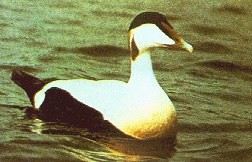 Synonyms: None.
Synonyms: None.Somateria mollissima (Linnaeus, 1758)
 Synonyms: None.
Synonyms: None.
Common names: Bulg: Obiknoveva gaga; Engl: Eider; Rom: Eider; Russ: Gaga obyknovennaya; Turk: Pufla; Ukr: Gaga zvychayna.
Order (Scientific): ANSERIFORMES.
Family (Scientific): ANATIDAE.
Taxonomic descriptions: A common species throughout its world breeding range. BS - in small numbers Eider occurs on the Bulgarian and Romanian Black Sea coasts. NB - there is the only isolated local population in Ukraine on the islands of the "Chernomorski" reserve known from 1975. In 1990 there were 678 pairs.
 IUCN Status:
IUCN Status:
World level:
Black Sea Regional level:
Subregion level: VU (Ukraine sector)
Distribution:
Habitats type, Critical habitats, Limiting factors: In Ukraine the habitats are small islets with reed beds, although within its main breeding range Eider prefers rocky or stony island coasts often with arboreal vegetation. In cold winters such habitats are often destroyed by the cracking flues, which may wipe off low parts of the islands and reeds. On the most densely populated Kruglyi and Dolgi islands in Yagorlytzki bay the area of these habitats is sharply reduced under such unfavorable conditions. The absolute majority of the nests is made in the shore reeds (in some years up to 63%), less frequently in the reed-beds around inland lakes, in the growths of sagebrush (Artemisia). Some of the nests may be located openly on the cast ashore aquatic vegetation along the bay coast. Major limiting factors are nest and chick predation by Yellow-legged Gull (Larus cachinnans), reduction of mussel bed area, hunting (these credulous ducks are easily shot down), dying in fish-nets.
Biology: The first birds arrive in the 2-3 ten days of March. Clutches are found from the end of the month, fall egg laying is observed in April and the first part of May. Second year females start breeding in early June. Breeding density can vbe ery high (up to 5 nests/m2). Clutch size varies from 4 to 8 eggs, normally 5-6. Those of 9-16 eggs are laid by two females. No second breeding is recorded. Incubation lasts for 26-28 days, hatching is well synchronized. The first broods appear at the end of April. In July-August juveniles together with the females aggregate in large flocks up to 3,000 birds and stay along the coast of the Tendra and Dzharalgach bays. A part of the Black Sea population winters in the bays within the area of the "Chernomorski" reserve or moves offshore. The major part of this southmost isolated population winters along the Bulgarian coast of the Black Sea. Diet basically consists of molluscs (mussels predominate), also small crabs and copepods are consumed.
Population trends: Decrease, birds redistributing over the islands of Tendra bay.
Threats: Nest and chick predation by Yellow-legged Gull (Larus cachinnans), reduction of mussel bed area, hunting, dying in fish-nets.
Conservation measures taken: The species is protected in the "Chernomorski" reserve.
Conservation measures proposed: Protection from the gulls, reduction in fox numbers, strengthening of protection regime in general, decrease in pollution.
References:
Compiled by: T.Ardamatzkaia.